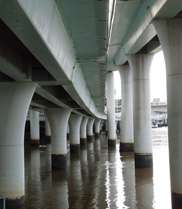Concrete answers needed for climate change effects

Understanding how climate change could impact on the deterioration of the basic building block of much of Australia's infrastructure – concrete – is crucial to ensuring major assets such as roads, ports and buildings continue to perform up to expectations, according to a CSIRO report.
"In order to better understand how climate change might influence infrastructure maintenance and construction, we need to establish an accurate national database on the rate, and factors involved in, the deterioration of concrete infrastructure," says the report’s lead author, CSIRO Climate Adaptation Flagship's Dr. Xiaoming Wang.
"Failure to consider the effects of climate change may compromise the safety of concrete structures but, overcompensating in our efforts to adapt for climate change may unnecessarily increase costs."
Concrete deterioration is caused by a range of physical, mechanical and/or chemical factors.
One of the major threats to the longevity of concrete structures is carbonation, which occurs when atmospheric CO2 penetrates into the structure to expose steel reinforcements to corrosion.
Corrosion caused by chloride penetration is another serious threat to concrete durability causing cracking, delamination, or spalling, especially in marine and coastal areas.
"Both corrosion mechanisms are influenced by climate change but, the time it will take for climate change to exacerbate carbonation and chloride-induced corrosion of concrete structures will depend on their location and level of exposure to the elements," Dr. Wang said.
He said the durability of concrete structures depends on the method of construction and types of materials used, and the environmental conditions they are exposed to.
"Currently, the primary assumption in construction designs is that environmental conditions will be similar to those of the past.
"However, scientists and engineers from CSIRO, in collaboration with a colleague from the University of Newcastle, have shown that increased atmospheric CO2, in addition to a changing climate – including 'chronic' factors like increasing CO2 concentrations, temperatures and humidity, and ‘acute’ factors like extreme weather events – will alter environmental exposure of most concrete infrastructure over their relatively long lifetime.
"This means that concrete structures will generally deteriorate faster with major implications for the safety, serviceability and durability of infrastructure, particularly in warmer inland and coastal areas," Dr. Wang said.
Provided by CSIRO











.jpg)





